Table of Contents
Top Choice
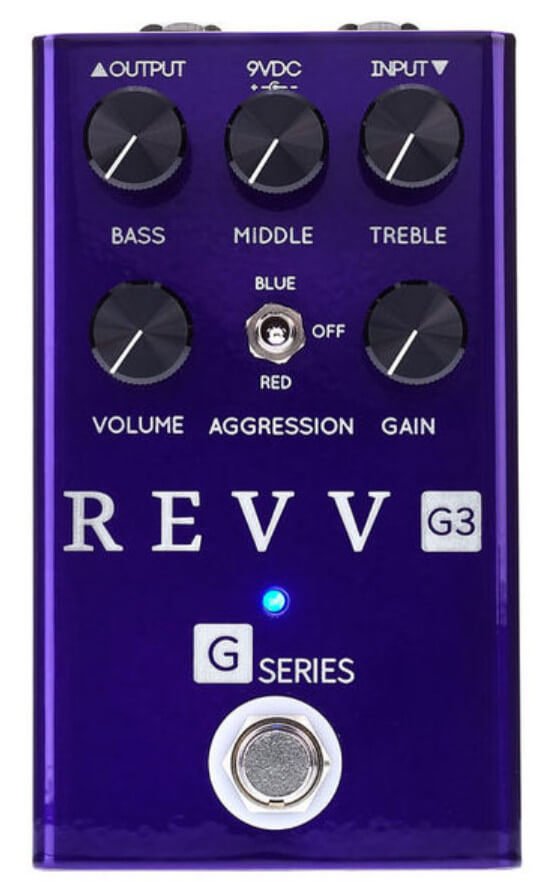
1. Revv G3 Distortion
The Revv G3 is a smooth sounding distortion pedal that is very amplifier like. It doesn’t have a gritty clipping sound but emulates tube tone well. Plus, the controls add incredible versatility! This makes it my top choice!
Best Budget
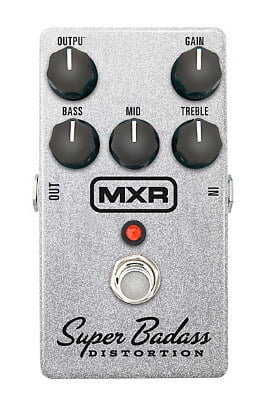
2. MXR M75 Distortion
The MXR M75 has a lighter gain sound. It can do anything from blues to hard rock and has a great EQ. This is our best budget choice because the price is good for the sound that this pedal can provide!
Editor’s Choice
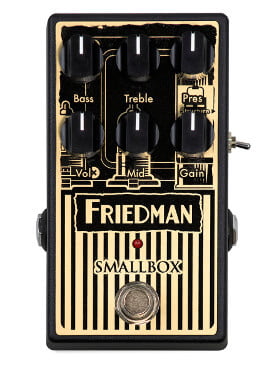
3. Friedman Smallbox Pedal
The Friedman Smallbox is a rock machine! It’s very Marshall like with a lot of versatility. The tones are smooth and amp like, and the feel is on point. It’s a very responsive pedal.
Best Distortion Pedals
I have collected and tried some of the most popular pedals on the market! Made by some great builders. Some are well known, and some are not.
These pedals are becoming popular because word of mouth is very positive for them. While some pedals develop hype, sometimes it’s very real!
If it was getting good feedback from players, we purchased it to try for ourselves. And sure enough, they are as nice as they are made out to be! Some are now on our personal pedal boards because they are just so good!
Revv G3
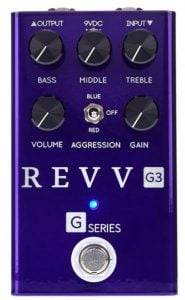
Features
- Top mount jacks.
- 3 band EQ.
- True bypass circuitry.
- 1M Ohm Input Impedance.
- 1-year warranty.
Score
Revv G3 Score
Overall
-
Build Quality
-
Sound
-
Versatility
-
Ease of use
Build Quality
The build quality of the Revv G3 distortion pedal is impressive. It weighs in at a very light three quarters of a pound. Its dimensions are 4.7″ x 2.75″ x 1.25″. The pedal’s housing is made of aluminum and is a custom enclosure.
Even in low-light conditions, the laser-engraved text remains readable and clear. It’s super simple to attach cables thanks to the top-mounted jacks. This is also excellent for managing the space on a pedal board.
The true bypass circuitry of the pedal makes sure that when it isn’t in use, it doesn’t affect the tone of your guitar. The G3 is expertly constructed overall and should withstand heavy use.
Sound
The Revv G3 produces a rich, saturated sound! It’s particularly well-suited for hard rock and metal genres. It has a large low end but is tight! In terms of gain, there is more than enough for anyone here. Each level of aggression getting even more fire-breathing.
To further characterize the sound, the pedal has a frequency response range of 70Hz to 15kHz. There is a strong signal-to-noise ratio.
As a result, when it’s idle, you will hear some white noise. This is due to the high levels of gain. But most players who like high-gain tones will be used to this.
Additionally, the pedal is able to produce a wide range of harmonics. This is what provides its tube like sound, and it’s great!
Overall, the sound quality of the Revv G3 is exceptional! It’s able to deliver a wide range of tones that are both versatile and satisfying.
G3 Audio Sample
The audio sample below provides an excellent example of what the Revv G3 sounds like in action. It’s set to blue aggression with the controls set to noon.
Durability
Durability is an important factor to consider when evaluating a distortion pedal. It will be subjected to regular use and transport to gigs and rehearsals.
In the case of the Revv G3 distortion pedal, the unit is built with high-quality components. The switches are robust and the jacks smooth.
The pots feel good and are not cheap. Additionally, the pedal comes with a one-year warranty. This provides further reassurance of its durability!
Overall, it appears to be a sturdy and reliable unit. It should stand up well to regular use over time.
Ease of Use
The Revv G3 has a very intuitive layout. Everything is marked well, and the control are arranged in a well known manner. It has a simple layout with a great EQ and the switches are not confusing. The pedal does have a manual, so anyone can understand how to use it.
The polarity is marked on the pedal as well, which is great. This way, a person will know exactly how to power it. It’s not capable of using a battery and must be powered with an external supply.
A power supply is not included with the pedal. But because it only consumes 14mA of electrical current, any supply will work.
Who Is It For?
The G3 is perfect for guitar players who want a more modern, aggressive sound. It’s wonderful for hard rock, metal, and even mid-scooped tones. It has a lot of gain, so it’s not great for light Stratocaster tones.
The Revv Amplification G3 distortion pedal is one hot stomp! With some tube-like saturation and smooth gain, it’s an amp in a box! The G3 is a high-gain pedal with some great tube amp-like tone.
PROS
- Premium grade build.
- Aggression switch.
- Tube like sound.
- Great tones.
CONS
- Not capable of using a battery for power.
Friedman Smallbox

Features
- Side mount jacks.
- 3 band EQ.
- True bypass.
- Tight switch.
- Warranty: 1 year.
Score
Smallbox Pedal Score
Overall
-
Build Quality
-
Sound
-
Versatility
-
Ease of use
Build Quality
The Friedman pedals are well known in the music world. Their sound is considered to be some of the best. But what about build quality?
The Smallbox, like most of the Friedman pedals, are built into a 125B style enclosure. This is a cast metal enclosure that offers decent durability.
The foot switch feels pretty robust. After a number of presses, it still feels strong. The knobs all seem like quality parts, they respond as they should.
The only concern I have with this pedal is the switch on the side. It could get sheared off if someone accidentally steps on it.
Sound
There are big tones found in this pedal! The switch on the side changes the gain structure of the pedal.
When I first played it, the switch was set to low gain. I thought it was a depth function at first. I really liked the sounds it was providing. But I thought, is that really it? Then I used the switch.
The thick gain tones really came to life! I like the range of the EQ, the tone shaping is powerful. This pedal is a great sounding piece of equipment. In some ways, I think it’s their best one. Thanks to the Mid-range control on the side, you can get some good sounds.
Audio Sample
Here is an audio sample that provides the sounds that this pedal is capable of providing.
Durability
When it comes to the durability of the pedal, it’s not bad. The controls and foot switch seem solid, and I believe they will last. Even the jacks feel smooth and don’t require a bunch of effort to insert a cable. But I’m worried about the switch on the side.
I think this could have been done better. I fear that I will step on the switch by accident and break it off. This to me should have been considered. I know room is an issue, but maybe a different kind of switch could have been used.
Ease of Use
Overall, the Smallbox pedal is easy to use. All the control are labelled, and they are easy to understand. But out of the box, it’s not clear what the switch does.
I also couldn’t find a manual to help me understand. Just so you know, it changes the amount of gain and voicing in the sound.
Who Is It For?
The smallbox is for guitar players who want a Marshall Plexi tone in a box. It does some great higher-gain sounds as well.
Friedman’s pedals are known for their great amp-like tone! The Smallbox distortion is another hot addition to an already awesome line! It offers a hot-rodded Marshall Plexi style tone that is glorious!
Done only as Friedman can! It’s also worth mentioning that this device is made after the Smallbox amplifier.
PROS
- Build quality.
- Plexi sounds.
- 3 band EQ.
- Gain structure switch.
CONS
- Side mounted jacks.
- Switch on the side could get sheared off.
Jackson Audio Asabi
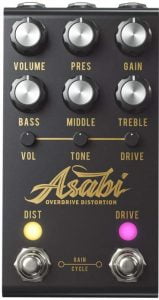
Features
- Top mounted jacks.
- Active 3 band EQ.
- True bypass.
- MIDI.
- Weight: .82 lbs.
- Warranty: 1 year.
Score
Build Quality
The Asabi is a well-made pedal. It’s soft touch switches and solid enclosure and a nice feature. At just under a pound, the pedal is a typical weight. It won’t make your board any heavier than other options.
The jacks are all top mounted, which in my opinion is a must. It helps to provide that extra space on a pedal board and keep cables from getting cluttered.
The circuit board contains surface mounted components. Which is normal to find in a product with these capabilities.
The knobs all feel quite nice when turned and are rigid. These are all indications of a well-made pedal.
Sound
For this demo, I used the Boss Katana amplifier using a clean sound and started with the drive side of the pedal. The guitar was the Fender Stratocaster and right away the crunchy sound was perfect. It has a ton of spank and seemed very tube-like.
For the distortion side, I used a PRS custom 24 and was not disappointed. The pedal was able to get some great rock and metal tones.
It has different clipping modes, and they sound pretty good. Some are more saturated than others. Some were a bit fuzzy, but over all I liked them.
In the video below, you will find a range of tones capable with the Asabi. You will also see how different guitars sound through it.
Durability
The durability of a pedal is of great importance. They get tossed around and stomped on, sometimes every night! And I’m happy to report that the Asabi is a pretty durable pedal! The quality of components and design by Jackson audio is top-notch.
The soft switches used in the pedal are quite standard but are known to be durable. The knobs all turn nice and don’t feel of poor quality. Even the mini pots turn nice and are mounted well to the PCB inside.
Ease of Use
There is a lot going on in this pedal. Many sounds can be obtained and all made possible by settings. On the surface, the graphics and text are easy to read and make sense. But the ease of use with the different sounds can be confusing at first.
The ease of use gets a lower score for this reason. It’s not overly complicated, but you will need the manual right out of the box.
Who Is It For?
This Jackson Audio Asabi distortion is best suited for guitarists who want a wide range of tones. Plus, lots of modern controls! The range is huge!
The pedal is the work of Jackson Audio and Mateus Asato. It doubles as an Overdrive as well and sounds great! Mateus Asato and Jackson Audio have created a masterpiece of a pedal. Stock the sound is that of a hot-rodded JCM800 with some incredible clarity and lots of gain.
The device features MIDI control and some other great options. It also has a built-in overdrive section that is controlled opposite the distortion. Not only can you boost it, but you can use each of the sides individually. It’s a great-sounding pedal with a ton of options!
PROS
- Active 3 band EQ.
- MIDI control.
- Great Sound.
- Overdrive built in.
CONS
- Very expensive.
Revv G4
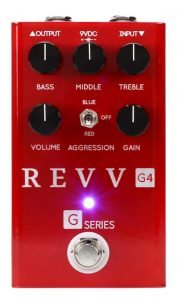
Features
- Top mount jacks.
- 3 band EQ.
- True bypass.
- Weight: .71 lbs.
- Revv Warranty: 1 year.
Score
Revv G4 Score
Overall
-
Build Quality
-
Sound
-
Durability
-
Ease of use
Build Quality
Another home run product by Revv. Just like the G3, you can find a well-designed product with high quality components here. The weight is the same at around .7 lbs. It also uses the same aluminum enclosure that gives it rigidity.
Revv is known for producing good products out of Canada. When I dialed in a sound I liked on the G4, it was apparent to me that they don’t mess around! Great build quality can be found in the G4 as far as I’m concerned!
Sound
Compared to the G3, this sound is thicker and bolder, but less saturated. The pedal features a 3-band EQ and gain-altering switch. It increases bass and mid-content. It’s a great-sounding pedal and when used with the Generator MK3, it is very close to channel 4.
Audio Sample
Here is an audio sample that showcases the range of sounds possible with this pedal. The aggression switch is set to off and the controls are close to half way.
Durability
The G4 is one durable pedal. The switches are all robust and feel solid when depressed. The knobs turn with a bit of resistance. This is important as cheap knobs turn loosely. The jacks feel smooth and don’t require extra effort to connect a cable.
I also really like the fact that the text is laser etched to the enclosure. Even that provides durability as it will never wear off!
Ease of Use
The G4 is an easy-to-understand pedal right out of the box. There is an instruction manual provided by Revv at their website if you are not sure.
But the layout is standard, and the controls are intuitively arranged. Even the polarity has been accounted for, which makes connections easy.
Who Is It for?
The G4 is for players who like thick modern metal sounds. It’s very capable of doing great rock tone as well, thanks to the aggression switch. The G4 is made after Revv’s red channel amp tone. It’s another seriously good-sounding effect!
PROS
- Premium parts.
- Thick heavy tone.
- Aggression switch.
- Top mount jacks.
CONS
- Less saturated than the G3.
- Not capable of powering with a battery.
Vox Cutting Edge
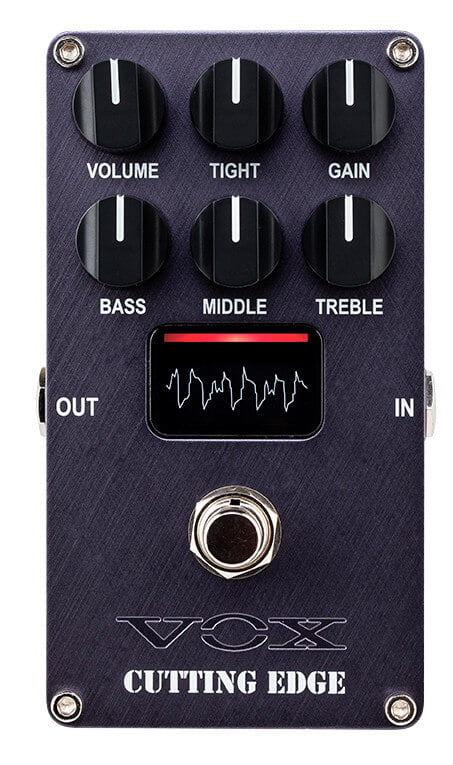
Features
- Side mount jacks.
- Accepts a battery.
- 3 band EQ.
- Cab Simulation.
- Weight: .86 lbs.
- Vox Warranty: 1 year.
Score
| Feature | Rating (1-5) |
|---|---|
| Build quality | 4 |
| Sound | 3.8 |
| Durability | 4 |
| Ease of use | 4.6 |
Build Quality
The Vox Cutting Edge pedal comes in a custom enclosure that screws together from the top. It’s a nice looking chassis that’s anodized, giving it a metal look.
The quality of the parts are good. They feel robust and are not cheap. It has side mounted jacks though, which is a shame. I prefer top mount.
It even has an oscilloscope screen that measures your signal as you play. Not sure why, but it’s there. It seems to be of good quality, but it’s unique to this pedal, and so I can’t comment on what would happen if it broke. But there is a warranty that will cover you if it does.
Sound
To be honest, when I tried the pedal knowing it was made from Vox, I didn’t expect much. It’s not that the reason is that it’s made from Vox. No, Vox is a great company! It’s that this is a metal pedal and Vox is known for vintage tones.
But I’ll be honest, it’s great! This little pedal does some great metal sounds. It’s thick, tight and has a good mid-range.
The treble has just enough bite without being brittle or harsh. And it saturates really nicely. Here is a video that runs through the tones you can get with this pedal.
Durability
The screen on the front is the only thing that I would be concerned about. I’m not sure how long it will last if the pedal is treated roughly. It seems ok after the treatment I gave it. And so far, it’s good. Otherwise, everything else seems pretty tough.
I suspect the pedal will be able to take nightly touring and gigging like a champ. It’s pretty solid and is well-made.
Ease of Use
I found the Cutting Edge to be very easy to use. The controls are labelled well, and the layout is good. It’s intuitive, and I had no issues getting going. The polarity is marked on the enclosure, which I appreciate. Not all pedals have this, but it’s important.
Plus, Vox has a great manual available that helps you along should you get stuck. There is a mode switch that is on the front, I did need the manual to figure out what it was for.
The link connector was another item I wasn’t sure about. But you can connect the Vox pedals together this way.
Who Is It For?
The cutting edge is for players who want high-gain metal sounds. But also a cabinet simulation option in one package.
Vox has created a high-gain distortion pedal with Nutube technology. This unit is a great-sounding addition to their Valvenergy line.
Vox has released a new breed of pedals using their Nutube technology. The Cutting Edge distortion is their metal stomp in the Valvenergy series.
PROS
- Parts and hardware.
- Cabinet simulation output.
- Good metal tone.
- Vox link technology.
CONS
- 2-hour battery life.
Fender MTG Tube
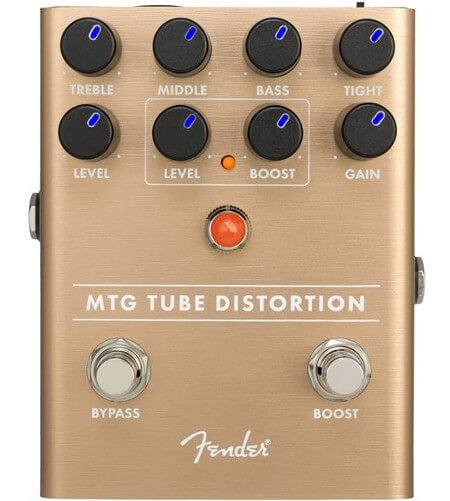
Features
- Side mount jacks.
- Overdrive on board.
- 3 band EQ.
- Real Tube Inside.
- Weight: 1.2 lbs.
- Fender Warranty: 1 year.
Score
| Feature | Rating (1-5) |
|---|---|
| Build quality | 4.2 |
| Sound | 4 |
| Durability | 4 |
| Ease of use | 3.8 |
Build Quality
Fender is known for making great gear! This is another wonderful product that is made well! The custom enclosure is a really nice touch. Made from aluminum and anodized. It’s a larger pedal and so it will take up more room on your board.
The knobs light up, making it easy to see your settings in the dark. The switches and potentiometers all feel good. You can tell they are of good quality. I give the pedal 2 thumbs up for build quality!
Sound
This pedal is like a vintage Fender amplifier in a box. I ran it into the front of the Fender Champion 100, and it was the perfect match. The MTG is very tube-like and warm sounding. It has a great vintage feel and sound to it.
The boost was a nice touch, as it can be kicked up in either gain or volume. It also had a good response to the guitar volume control when I wanted to back it off. Check out this video to hear how it sounds. You will also see how it functions.
Durability
The question is, can it withstand regular use? I would have to say yes! After using it for a number of weeks, there really is no concern of anything failing. Now, it does have a vacuum tube inside which could fail. But otherwise it’s built well and should stand heavy use.
Who Is It For?
This MTG tube distortion is best for players who want a more vintage sound with great controls.
The Fender MTG pedal is a distortion with a real tube inside. They used a NOS tube with a plate voltage of 150 VDC. This provides a good amount of headroom when you roll off the volume on your guitar.
Not only is it a distortion pedal, but it also has a built-in boost. This option allows you to either boost your gain or volume, or both! When you press the foot switch, the added gain and level control are put into the circuit.
PROS
- Nice enclosure.
- Light up knobs.
- Good vintage tone.
- Real 6205 preamp tube.
CONS
- The tube inside would need to be replaced if it fails.
Boss DS-2 Turbo
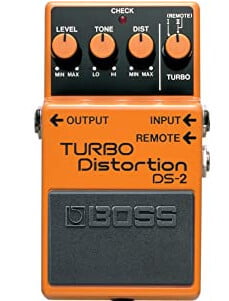
Features
- Side mount jacks.
- Accepts a battery.
- Remote Jack.
- Buffered bypass.
- Weight: 1 lbs.
- Boss Warranty: 1 year.
Score
| Feature | Rating (1-5) |
|---|---|
| Build quality | 4 |
| Sound | 3.8 |
| Durability | 4.2 |
| Ease of use | 4 |
Who Is It For?
This pedal is good for anyone who needs a unit that can do many tones. It has a good sound and can be switched on the fly. Good bang for the buck here.
Boss has been around for a long time. They have made some great pedals for many decades, the DS-2 lives up to the legacy.
This pedal has 2 modes that can be controlled even by using an external foot switch. This is great if you are using different sounds live and need hands-free.
It’s capable of low gain that can be great for sounds in blues, rock, and grunge where the settings can be sharp. Then it can dip into metal territory with a sound that is dark and deep. It’s a pretty versatile pedal.
Sounds
I used the DS-2 in front of a Fender Champion 100 amplifier. This was to try and get some bright and clean tones when it was turned off. When set to Turbo 1 mode, the distortion was pretty powerful and had a flat EQ.
This made it darker, which was good for heavier music. I was able to dial in some hard rock and metal tones this way.
In turbo-2 mode, the pedal became spicier in the top end and had more bite. This was great for the lower-gain stuff. I found myself using a Fender Telecaster here as it had some great sounds. Even for stuff like Red Hot Chilly Peppers.
MXR M75

Features
- Side mount jacks.
- Accepts a battery.
- True bypass.
- Weight: .53 lbs.
- Warranty: 1 year.
Score
| Feature | Rating (1-5) |
|---|---|
| Build quality | 3.6 |
| Sound | 3.5 |
| Durability | 4 |
| Ease of use | 4.5 |
Who Is It For?
Players who need some sort of gain option that can do more than one sound. All at an affordable price will benefit from this one.
MXR has put out a great pedal called the M75 Badass. It’s a pretty versatile little unit that can take you from vintage 70s rock to modern metal. The EQ is very responsive, which is helpful in getting some good sounds.
All jacks are side mounted on the rugged enclosure, and it is a true bypass when switched off. This is a great option when you own an amp that doesn’t have a gain channel. This little pedal can get you all the tones you would need.
Sounds
With this pedal, I used the Fender Champion 100 set to clean. Turning it on with everything set at noon presented a decent rock tone with a PRS guitar with humbuckers. After tweaked the gain and EQ, I was able to get some good heavy sounds and decent rock.
With a Fender Telecaster, I was then able to get more vintage rock sounds and even some blues. It’s a good pedal with a decent tone across the board, and the price is right.
Boss MT-2 Metal Zone
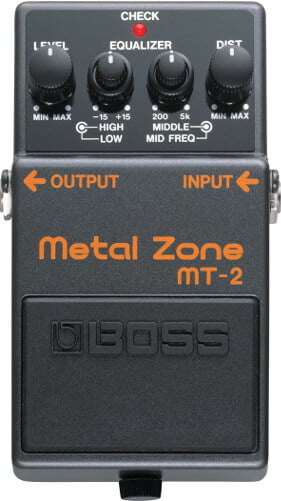
Features
- Side mount jacks.
- Accepts a battery.
- Buffered bypass.
- Weight: 1 lbs.
- Warranty: 1 year.
Score
| Feature | Rating (1-5) |
|---|---|
| Build quality | 4 |
| Sound | 3.2 |
| Durability | 4 |
| Ease of use | 4 |
Who Is It For?
Metal players who like thick, heavy distortion will like this. If you need some sustain for leads, this is a great pedal to consider. Especially for the price.
The Boss metal zone is a thick-sounding distortion. Its circuit is designed around a dual-gain concept that gives it tons of saturation. The EQ is a semi-parametric design that allows you to boost or cut frequencies.
This pedal will provide great sustain for leads and a thick mid-range for a chunky rhythm. It’s a very popular pedal and has been used by some well-known artists, one being Prince!
Sounds
If you are typically after old-school metal, this is a great pedal, and it does it well. The EQ is sensitive and so it has very effective controls.
The bass is prominent, but it still has a decent mid-range. I preferred this pedal in the FX loop of the amplifier, as it sounded heavier this way.
Behringer HM300
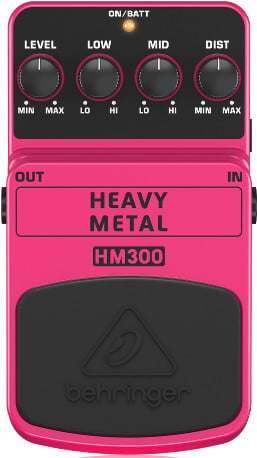
Features
- Side mount jacks.
- Accepts a battery.
- Buffered bypass.
- Weight: .51 lbs.
- Warranty: 1 year.
Score
| Feature | Rating (1-5) |
|---|---|
| Build quality | 3 |
| Sound | 3 |
| Durability | 3.5 |
| Ease of use | 4 |
Who Is It For?
This pedal is intended for guitarists who want a chain saw sound for death metal tones. Nothing more. But it’s quite good at it.
This one surprised me a bit when I tried it the first time. The Behringer HM300 is a super cheap pedal that you wouldn’t expect to sound very good. It is a clone of the HM-2 and so if you are into Swedish death metal tones, this is your one-trick pony.
The controls don’t work as you would intend them to, but the HM-2 was sort of the same way I remember. But if you want a chainsaw sound from your pedal, it does it all day long.
PROS
- It’s cheap.
- Does Chainsaw sound well.
- Does some metal tones well.
CONS
- Plastic Housing.
- It’s pink.
What Is Distortion?
Distortion is an effect that alters the sound of an electric guitar signal. This is done intentionally by clipping the signal, which distorts it.
This adds harmonic content to create a more aggressive, gritty tone. Distortion can range from subtle and warm to extreme and harsh.
Depending on the amount of gain applied and the hard or soft clipping technique used. It’s a popular effect among guitarists in a variety of genres!
From rock and metal to blues and jazz. It’s often used to add character and depth to guitar solos. Or to create a more powerful and aggressive rhythm sound.
Do You Need to Use a Distortion Pedal?
Not every guitar players needs a distortion pedal. If you play cleaner guitar styles, then there is no need for distortion.
But if you’re a rock or metal player, distortion is a necessity. This is the sound that makes metal possible. It adds the character needed to get the right sound.
If you are trying to sound like a famous artist, see what they use. If they play a more aggressive style of music, then chances are you will need to have a distortion pedal. But not all pedals are the same. And so make sure to get the one that will meet your needs.
What To Look For In A Distortion Pedal
Because there are a lot of distortions on the market today, you have to know what to look for. Many players are into lots of sounds!
Sometimes you may gravitate towards one, or sometimes many! But you have to choose the right stomp box to get your sound, otherwise, you will be disappointed!
And with so many companies adding a lot of control options and functionality, it’s easy to get what you need. So when choosing a distortion pedal, make sure to look for these key features:
- The genre of music the device was created for.
- Lowest and highest gain the unit can produce.
- Functions and options for control.
- Build quality.
The pedal has to be able to make you happy when it can produce the sound in your head! This is the number one point! If its aim is rock, and you’re looking for searing metal, you will be disappointed!
Also, make sure it has the number of options you need, some pedals do a lot! And when you need control options, in this day and age, that’s easy.
Final point, make sure to watch some videos, you can learn a lot from them, which is why we have created these articles. We load them with everything you need to know to make the right choice!
Final Thoughts
Luckily, not only are pedals getting better, but so is customer service from a lot of retailers. This makes it easy to try the different distortion pedals.
It’s all about getting the right pedal for your needs. We hope these guides have been helpful, be sure to share them with others if so. Someone else will be on the same journey for the perfect distortion! Just make sure to have the right supply!
Top Choice

1. Revv G3 Distortion
The Revv G3 is a smooth sounding distortion pedal that is very amplifier like. It doesn’t have a gritty clipping sound but emulates tube tone well. Plus, the controls add incredible versatility! This makes it my top choice!

